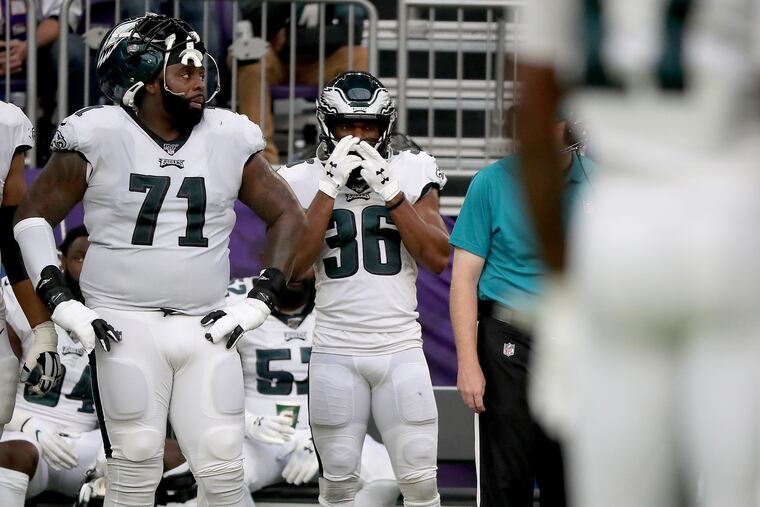The good news is the Eagles have just a few problems. Here’s the bad news ... | Mike Sielski
Those few problems have been big problems. They were predictable, and they’ve rippled throughout the team.

It is tempting, with the Eagles at 3-4 following back-to-back embarrassing losses to the Vikings and Cowboys, to paint every aspect, every position group, every player on the roster with the same brush of incompetence.
If Carson Wentz were a true franchise quarterback, he’d be carrying his team to victory and overcoming any obstacle in his path. … If Doug Pederson were really a genius, he wouldn’t hand the ball to Miles Sanders on third-and-4. … And yeah, Jake Elliott hasn’t missed a kick all season, but would it have killed him to throw a better pass on that fake field goal?
When a team fails to live up to high expectations, when things are as bad as they’ve been lately, everyone looks like a target for blame.
The truth, though, is that not everyone is or should be. I’m not suggesting that Wentz or Pederson has been beyond reproach or criticism this season. (Elliott pretty much has.) I’m suggesting that rather than having issues or shortcomings everywhere, the Eagles have had a few particular problems of great significance, and the consequences have rippled throughout the team throughout the season.
“It speaks to the ability of a team to adjust and adapt,” safety Malcolm Jenkins said Tuesday. “If one person steps out of the offense or steps out of the defense and everything falls to s---, then you’re not adjusting or making the changes necessary. We hadn’t really had that problem until this year, where you’re starting to see some of those things show up. But like I said, it’s less about the scheme or the players who are out there and just the lack of ability to make up for that in strategy or guys executing. It makes it a lot easier to execute when you’ve got your best players out there. When you don’t, all of a sudden small mistakes become bigger mistakes and have a larger effect on the game.”
What Jenkins was speaking to, whether he intended to or not, was the precarious nature of the roster that Howie Roseman and his staff constructed in the offseason – and the troubles that the coaches have had in extracting excellence from it. The Eagles left themselves vulnerable in three key areas, and those areas have since become three big problems.
Big Problem 1: The lack of depth along the defensive line
The loss of defensive tackle Malik Jackson in Week 1 to a foot injury damaged the Eagles within their most important defensive unit. Jim Schwartz’s entire scheme is predicated on his four down linemen generating pass pressure and disrupting an opponent’s running game without needing to blitz.
When the Eagles sustained a series of injuries to their secondary last year, including a season-ender to safety Rodney McLeod, they withstood it. “We went to a very, very simple scheme and let our defensive line eat,” Jenkins said. “Little bit different situation this year. The line … we’re thin there.” One could argue, in fact, that because they said goodbye to proven pass-rushers Michael Bennett and Chris Long, the Eagles were thin even before Jackson went down.
Big Problem 2: The health of Jason Peters and the inexperience of Andre Dillard
The Eagles hoped to squeeze one more full season out of Peters. It would have been a heck of a story if they could have. But Peters is 37, and he hasn’t been a reliable part of the Eagles’ offensive line since 2016. He started all 18 regular-season and playoff games last year, for instance, but missed at least one snap in 11 of them.
This season, Peters has missed more than 25% of the Eagles’ offensive snaps. Dillard, the team’s first-round draft pick this year, had to replace him mid-game against the Vikings and started in his place against the Cowboys. Though offensive coordinator Mike Groh said Tuesday that Dillard’s presence and inexperience had no bearing on the game plan against the Cowboys, the Eagles ran the ball on 13 of their first 18 offensive plays, an approach that appeared designed to protect a rookie left tackle. Peters’ age and unreliability and the line’s lack of continuity – hardly unpredictable developments – have done Wentz no favors. This was supposed to be one of the NFL’s five best offensive lines. It has not been.
Big Problem 3: The injury to DeSean Jackson
It’s not just that Jackson was supposed to be the Eagles’ primary deep threat this season – a role that an abdominal injury has prevented him from filling since his two-touchdown performance against the Redskins in Week 1. It’s that his absence has elevated other receivers into roles for which they’re either ill-prepared or unsuited.
Nelson Agholor, who thrived in the slot, has to play outside more, and Mack Hollins is now the No. 3 wideout, not the No. 4. Hollins has just one reception in his last four games and none in his last three, even though he has played roughly half of the Eagles’ offensive snaps over that stretch.
“Mack is another guy [who] has just done everything we’ve asked him to do,” Groh said. “The ball hasn’t found him.”
So, Hollins remains in the lineup. Guess they’ll have to bench the ball, then.